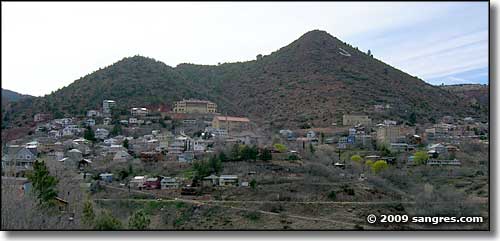
Jerome, Clarkdale and Cottonwood Historic Road

Looking toward Clarkdale and Cottonwood from Jerome, on the Jerome, Clarkdale and Cottonwood Historic Road
The Jerome, Clarkdale and Cottonwood Historic Road connect (you guessed it) Cottonwood, Clarkdale and Jerome. Jerome started as a copper mine camp in 1876. Perched on the steep side of Cleopatra Hill, Jerome used to sit on a fortune in copper, gold, silver and zinc. Eugene Jerome was a lawyer/investor who put in the seed money to get the United Verde Copper Company off the ground when he bought out the claims of those first 3 prospectors. He developed the underground mines a bit but he had neither the expertise nor the capital to do what needed to be done to develop the mine to its fullest potential. So he sold the town and the mining operation to William Andrews Clark, one of the copper barons of Butte, Montana, in 1888.
At first, Clark just worked the mine and made a good profit. Then there started to be problems with fires in the mines, and fires that burned off most of Jerome in 1897 and again in 1899. Because of the fires underground, United Verde had to convert its operations over to open pit mining. With that, the smelter on top of the mountain had to be removed. In 1910, Clark started building a new copper smelter down the hill below Jerome, just to the north of Cottonwood. In 1914 he built the town of Clarkdale around the smelter to house the workers. Clarkdale was a master-planned community from the beginning.
1912 is when James S. Douglas bought the claims to the Little Daisy Mine, just down the mountain from the United Verde's main diggings. He was gambling that a fault he thought he detected in the ground beneath the Little Daisy would be where the Earth had shifted and brought the richest part of the vein the United Verde was mining directly beneath his Little Daisy claim, and eventually into his possession. He turned out to be right. Douglas made millions, and built his family a beautiful mansion just down the hill from Jerome itself. That property is now the Jerome State Historic Park.
Back in those days, Jerome had a reputation as "the Wickedest Town in the West." Hotels and boarding houses popped up and in between them were bars, brothels and saloons... brawling in the streets over a drunken game of cards was common, as were scarlet fever and smallpox epidemics. But people poured in looking for work and the mine ran 24/7/365.
By the 1920's, Jerome's population topped 15,000 and sat in the heart of the largest copper-producing area in Arizona. Then the Great Depression brought it all to an end when the mines closed. The Little Daisy finally shut down for good in 1938. Demand for copper reopened the United Verde during World War II but production ground to a standstill in 1953 and has never re-started again. Jerome dwindled away to the status of a ghost town for many years, then was resurrected and is thriving now as an "arts and tourism" town. Clarkdale was "saved" by the construction of a large cement manufacturing plant on the edge of town.
Down the hill below Clarkdale is Cottonwood. Cottonwood was more of a homesteading/farming/ranching settlement. The original settlement was at an easy ford of the Verde River, along a trail that lead from Phoenix and Prescott to Camp Verde and Oak Creek. When the mines and smelters were going, Cottonwood really prospered as the nearest place of food production for all those workers, but when the mines fell off, so did Cottonwood.
Today, Cottonwood has somewhere around 6,000 residents. The original commercial settlement at Cottonwood is still preserved downtown in the "Old Town" district. The Chamber of Commerce is located in the former Cottonwood Jail, just above the Verde River Greenway in downtown.

Looking back up at Jerome from about halfway down the hill to Clarkdale

Jerome, Clarkdale and Cottonwood Historic Road area map
